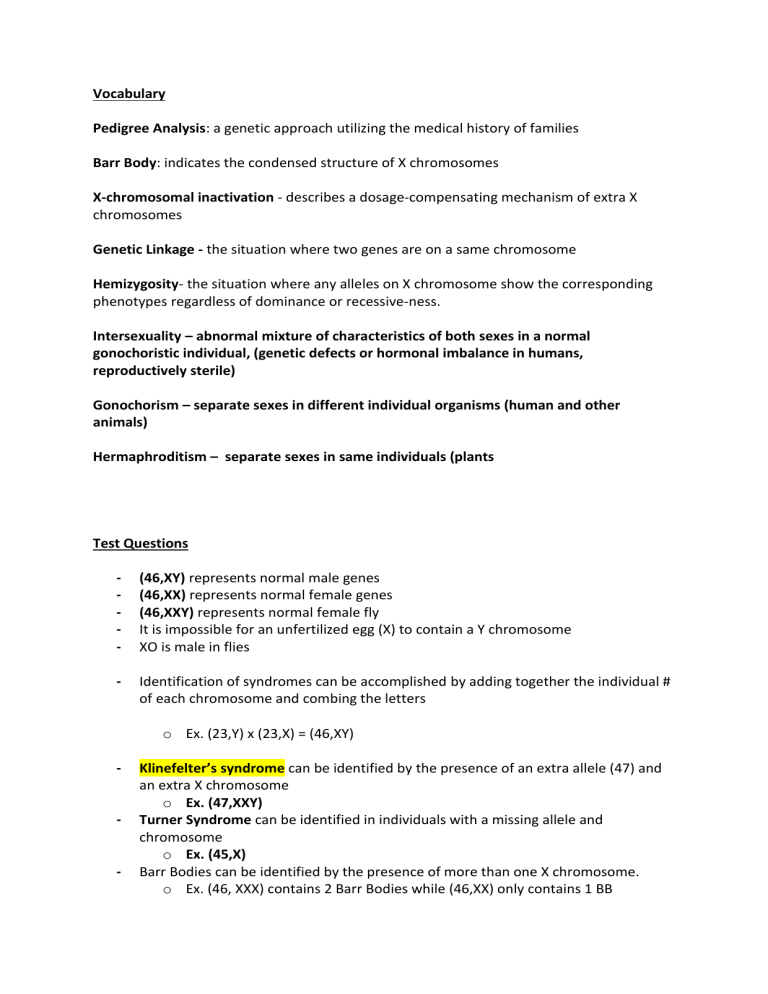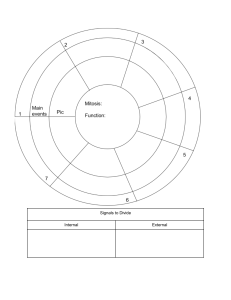
Vocabulary Pedigree Analysis: a genetic approach utilizing the medical history of families Barr Body: indicates the condensed structure of X chromosomes X-chromosomal inactivation - describes a dosage-compensating mechanism of extra X chromosomes Genetic Linkage - the situation where two genes are on a same chromosome Hemizygosity- the situation where any alleles on X chromosome show the corresponding phenotypes regardless of dominance or recessive-ness. Intersexuality – abnormal mixture of characteristics of both sexes in a normal gonochoristic individual, (genetic defects or hormonal imbalance in humans, reproductively sterile) Gonochorism – separate sexes in different individual organisms (human and other animals) Hermaphroditism – separate sexes in same individuals (plants Test Questions - (46,XY) represents normal male genes (46,XX) represents normal female genes (46,XXY) represents normal female fly It is impossible for an unfertilized egg (X) to contain a Y chromosome XO is male in flies - Identification of syndromes can be accomplished by adding together the individual # of each chromosome and combing the letters o Ex. (23,Y) x (23,X) = (46,XY) - Klinefelter’s syndrome can be identified by the presence of an extra allele (47) and an extra X chromosome o Ex. (47,XXY) Turner Syndrome can be identified in individuals with a missing allele and chromosome o Ex. (45,X) Barr Bodies can be identified by the presence of more than one X chromosome. o Ex. (46, XXX) contains 2 Barr Bodies while (46,XX) only contains 1 BB - Locus is another name for gene and is used when discussing a gene that displays incomplete dominance (blending phenotypes) o If the B allele causes orange color - X chromosome inactivation occurs when there are more than one X chromosome present o Ex. XBXB, NOT XBY - Pay attention to the capatilization of some Y genes, as the test has (y) genes that affect phenotypes and are not associated with sex chromosomes o Ex. w+y/w+y is female while w,y+/Y is male - When crossing individuals with w+y/w+y, remember that one w+y corresponds to an X chromosome, so both stay put when crossing o Check notes for examples - The “/” on genes means they are on the same chromosome. When crossing two parents with these genes, the F1 progeny will have one copy of the first one and one copy of the second one. The F1 generation must then be testcross with a homozygous recessive variant. The resulting F2 progeny will have two parental types, as in alleles that match the orientation of each perspective parent. The other two will be recombinant types, or those with a o Ex. FM, BD/FM, BD x fm, bd parents = F1= FM,BD/ fm, bd x fm, bd/ fm, bd Genetic Distance - Genetic distance = total number of recombinant types/total number of offspring - Genes with a + are wild type - Parent generation has one copy of pure mutant genes and one pure hereditary. F1 receives both genes - The frequency of recombination (%) has a direct correlation with how far two genes are on a chromosome. The smaller the frequency, the closer the genes o Over 50% means the genes aren’t on the same chromosome - When we talk about genes being linked, it means they are/aren’t on the same chromosome - When testing the F1 generation possessing three genes, always perform a testcross using a homozygous recessive individual - Inversion is 180o rotation of a segment of a gene. Two breaks occur in one chromosome and the region between the breaks rotates by 180o before joining, it creates a mutation, known as inversion. The location of the centromere relative to the inverted segment determines the genetic behaviour of the chromosome. o If the centromere is outside the inversion, it is known as paracentric inversion. (para-near) o If the centromere spans the inverted regions, it is known as pericentric inversion. (peri-on)(pericardium-on heart) - - - - Duplication is the occurrence of a segment of a chromosome in two or more copies per genome. the duplicated regions can be adjacent to each other or are distantly located on a chromosome. Deletion is the loss of the segment of a chromosome, it shortens the length of Translocation: Movement of short DNA segments from one position in the genome to another o Reciprocal Translocation: Two different parts of two chromosomes switch places o Non-Reciprocal Translocation – One part of a chromosome moves to a different chromosome To find which gene is in the “middle”, compare the genotypes of the parental and double recombinants and see which one switches, that is your middle Gametes produced from peri & paracentric conversions produce unstable gametes If an individual is heterozygous for a paracentric inversion, they will undergo dicentric chromatid or acentric chromatids after the crossing over CML (chronic myelogenous leukemia) is a blood cancer caused by the reciprocal translocation between human chromosome 9 and 22. o The translocation occurs between two genes, c-abl (Hsa9) and bcr (Hsa22) W is the reptile’s version of the human/fly Y sex chromosome. Remember that being a dude is a W XXY are females in flies but males in humans since they cannot undergo Xchromosome inactivation The phenotype with the largest # of offspring after performing a testcross are the parental types The phenotypes with lowest number of progenies are double crossover offspring. Hemizygosity: Means half. An allele will show its phenotype regardless of dominance or recesiveness, since there is only one available allele. o Males with only one copy of an X-linked gene are hemizygous for that gene 2020 Q22-24 22: Paracentric inversion – I, III, IV Pericentric inversion Reciprocal Transloaction – V Non-reciprocal Translocation – VI 25: look over in lecture

